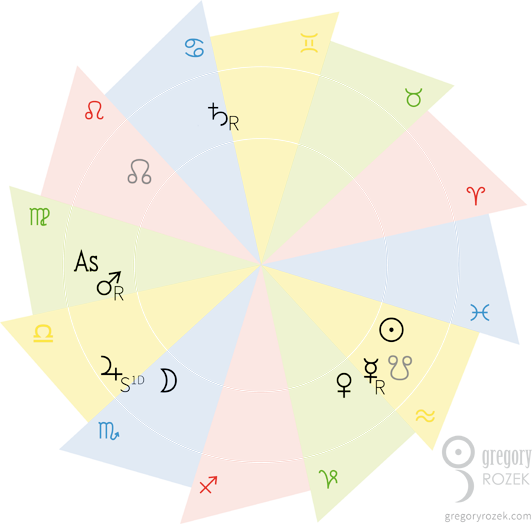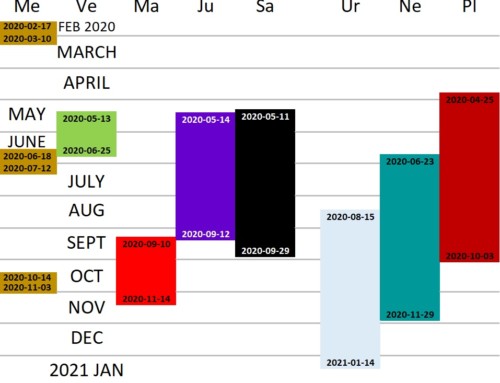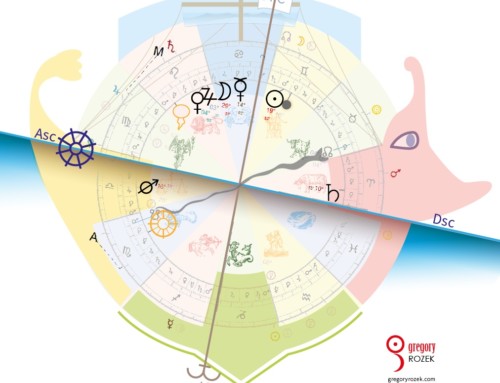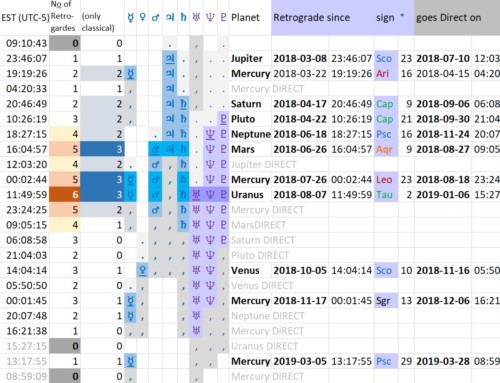This is the birth chart (thema natale) of Vettius Valens of Antioch that’s in my Polish article (which title would sound in English like: Daimonion on the way of Astrologer. Reflections upon the 3rd conference of PTA. Vettius Valens of Antioch, Jerzy Prokopiuk as a Hermesian Man, Erik van Slooten et al.)
Valens never gave us his natal chart directly. Though the scholars agree with Otto Neugebauer that the one chart that he mentions several times, and seems to know the native outstandingly well, is extremely likely his own chart. Like most Hellenistic astrologers, Valens gives the position of 7 ancient planets in signs only (no degrees). Neugebauer ascertained that the positions correspond for the native being born on February 8, 120 CE, around 7:00 PM in Antioch. We don’t know the exact degree rising, but we know that Horoscopos is in Virgo. We can’t also be sure if he was born in Antioch (current Turkey), because he never mentions that place himself, but based on the Codices scholars like Anna Komorowska (Polish author of a monograph on Valens, Vettius Valens of Antioch: An Intellectual Monography, Kraków 2004 – printed in Poland, though written in English) it is indicated that he was born there.
The positions of both Mercury and Saturn fall in different signs than in the natale described by Valens. If one would want to see the same sign placements of planets, one should display the chart in sidereal zodiac (common Lahiri works). It doesn’t necessarily mean that Valens used the sidereal zodiac! By the typical contemporary astrologers this could be explained by the fact, that the positions of planets assessed by ancient authors were very often a few degrees off, comparing to modern calculations. Especially for Mercury, which orbit was the hardest to observe due to proximity of the Sun. For Mercury and Saturn the 2 degrees here changes a lot – because they change signs there. Though it’s still intriguing that everything falls to “right place” in sidereal… But if you’d inspect the Anthology of Valens clearly, you’ll see that he regards the zero degree Aries as placed 8 degrees before the Vernal Point. This was a very popular view in the early Hellenistic astrology, and it comes directly from the Babylonian sources. Both Greek and Babylonian material we now have access to utilized only few versions of placing of the vernal Point. The two most popular were 8° Aries and 10° Aries. So we have authors using this or that starting point of the Zodiac, but it is always a whole number of degrees. But based on that we can’t call it a Sidereal astrology and not a Tropical one. How the system was seen at these time lies somewhere inbetween the Tropical and Sidereal or stellar zodiac tied to the stars. But because these two zodiacs coincided tightly at that time it is impossible put one or the other in the Ancient Greek’s mouths. Becuase that would be like forcing them to separate the two conjoined things and deciding which one they regard as a superior one and diminish the other. This is later and contemporary astrologers’ problem, not the Ancients’.
RETROGRADES IN HIS CHART
Either the British nor Polish version of my article on people with many retrograde planets in natal chart is still not available yet, but I’d like to address some points concerning that here, since in this chart most of the planets are retrograde. In the classical astrology of 7 planets: only the Aphrodite (Venus) is moving direct, and Zeus (Jupiter) is in it’s first Station – has apparently stopped but hadn’t changed his direction yet to retrograde. This is the “worst” section of the whole retrogradation period. I mark such planet as S1(D), meaning it’s Stationary, in the first Station (from Direct to Retrograde, not from Retrograde to Direct) and still in the direct (D) half of the Station’s period. By all means (coined out from traditional methods) this planet is already considered to act as retrograde, but absolutely not ready for that because of still being direct.
And looking from the modern astrology perspective: Uranus and Neptune are also retrograde, which gives us 5 of 7 possible planets in state of retrograde.
This asserts us how much Valens came close to the higher realms of perceiving the reality, though of curse not without the life difficulties, which by the way are necessarily for getting there. But more on than in the future writings. I’m only addressing this case here, to warn you from treating his chart with delicacy like if all the planets were direct.
Look for example what the ruler of the Horoscopos (Ascendant Ruler) – Mercury Retrograde, as well as it’s Ruler (Saturn-retrograde) do in terms of it’s direction and zoidions-topos (signs-houses) he crosses…








Thank you for every other great article. Where else could anybody get that type of info about Natal chart and Retrograde Planets in such an ideal means of writing? I am a keen learner of astrology techniques and so i used to search all the web for the related items. Basically i write about astrology compatibility and astrology birth chart making that why to make them and how to related to our personal life.